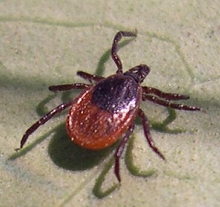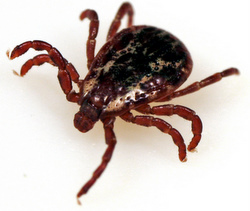This page focuses on ticks on dogs (for fleas, see our Dog Flea Medicine page), including…
- What are ticks and what can they do to your dog?
- Where are ticks found?
- How can a dog come in contact with them?
- What diseases do ticks carry?
- Combating ticks and the best flea and tick medicines
- Dog tick removal (on a separate page)
I can remember hot, steamy summers as a child, spent in the heart of Kentucky with my dear grandmother and her yard full of ticks. Now, you may think that crawling, biting bugs in the grass would deter our young feet from running shoeless through the grass…but no!
As a result, there were many nights spent sitting in the bathtub while Grandma treated the tiny bites running up and down our legs. And then, bright and early the next morning, we were at it again!
Fortunately, we were lucky enough to avoid the multiple diseases carried by these tiny parasites – but that is not always the case. It is important to educate yourself and inform your family about the necessity of effective dog flea and tick medicine and additional safety tips to keep your home tick-free…
What Do Ticks Look Like and What Can They Do to Your Dog?
Ticks are tiny parasites related to spiders and mites. They look like a combination of a spider with its eight legs and a dust mite with it’s large round body and tiny head.
Ticks live in grassy, brushy areas and tend to attach themselves to a blade of grass or the top of a shrub. It is said that a tick will sit and wait in one spot for weeks until a warm-blooded creature comes along.
Ticks then attach themselves and feed on the blood of their host. After feeding, they drop off to lay their eggs. Fun.
While there are many kinds of ticks throughout the world, these two are the most common in the U.S.:
Black-legged tick (pictured above right) – The black-legged tick is about the size of the head of a pin and can be found in many parts of the United States. It is known to be a carrier of Lyme disease, especially the ticks found in New York, New England and parts of the Midwest.
American dog tick (pictured right) – This type of tick is very common and is also found in many parts of the United States. It is much larger than the black-legged tick and can grow up to one-half inch long. It sometimes carries a disease called the Rocky Mountain Spotted Fever.
More details on each of these diseases are discussed further down the page.
Where are Dog Ticks Found?
Ticks are found in woods, fields, around water and in un-mowed grassy areas all over the world…
There are certain areas of the South, Southeast and Midwest United States that may have a higher number of ticks, but they can still be found in the mountains of the West and in the plains states.
Long story short…we are rarely in the clear.
How Can a Dog Come Into Contact with Ticks?
Dogs that are allowed to run loose on a farm, in a field or in the woods are much more likely to come in contact with ticks.
The ticks can attach themselves to your dog, feed on their blood, then drop off wherever they please to lay their eggs. Each fat, blood-engorged tick can lay up to 6,500! Obviously you don’t want this happening anywhere near your residence.
Ticks are in abundance during the summer months of April to August. If your dog plays in the back yard, make sure that the grass is cut on a regular basis. If your dog goes for a run in the woods, make sure to groom him and remove any ticks before letting him back in the car or your home.
It is also possible for small ticks to crawl inside the ears of your dog. If you get back from a hike and your dog is shaking his head vigorously for no apparent reason, take him into the veterinarian to get your dog’s ears checked.
What Diseases Do Dog Ticks Carry?
Ticks can cling onto you and your dog’s skin, clothes or head. Since their bites are not painful, you may not even notice, but they can carry some pretty serious diseases.
The two main diseases carried by ticks in the United States are:
- Lyme Disease in Dogs (on a separate page)
- Rocky Mountain Spotted Fever
Rocky Mountain Spotted Fever in Dogs and Humans
Rocky Mountain Spotted Fever (RMSF) is a bacterial infection transmitted by American Dog Ticks. The disease’s name is somewhat of a misnomer, considering that only 2% of the reported cases are from the Rocky Mountain region.
Regardless of its host, an infected tick has to be attached anywhere from 5 to 20 hours to transmit the disease.
Most of the reported human cases of RMSF were in the years 2000-2003 in the southern United States. The state of Ohio reported 42 human cases.
People of any age can become infected with RMSF, but about one half of the patients are under the age of 20. Most cases occur in the summer months (April to August) each year.
Symptoms of RMSF usually appear within 3 to 12 days after coming into contact with an infected tick. The initial symptoms often include fever, headache and aching muscles. A spotted rash usually develops on the wrists and ankles by the third day of fever. If left untreated, the rash will then spread to the rest of the body, including the palms and soles of the feet.
The human fatality rate for RMSF is about 4%, and that is mostly due to a delay in seeking medical treatment.
If you have been in any type of tick infested land and are experiencing any of these symptoms, over the counter dog flea and tick medicine will not help. Seek medical attention immediately.
Rocky Mountain Spotted Fever in dogs typically runs its course in about 2 weeks, but it has been found to kill some infected animals.
In other words, if your dog shows any of the following RMSF symptoms, get to the vet immediately:
- Onset of fever about 5 days after a tick bite
- Small, flat bruise-like dot on your dog’s skin
- Swelling of the scrotum, prepuce (area surrounding/protecting the penis or clitoris) and/or ears
- Joint swelling
- Trouble breathing
- A wide-based stance and swaying of the head and trunk (caused by neurological abnormalities). An infected dog may tend to lean and fall to one side.
Combating Ticks and the Right Dog Flea and Tick Medicine for Your Dog
The first step towards combating ticks is to be aware of the areas that are prime real-estate for ticks. This includes woods, fields, areas with tall grass and weeds and areas surrounding bodies of water, especially in certain regions of the country.
Always give yourself (clothes, skin and hair) and your dog a thorough once-over after walking in or around these areas. Use a fine-toothed comb on your dog. No ticks, no worries!
If you do find one, be sure to use the proper dog tick removal technique to avoid the risk of a secondary bacterial infection and reduce the risk of infectious diseases.
As far as prevention goes, there are several good natural dog flea and tick medicine choices on the market that can be brushed through the hair of your dog or applied to your clothing and skin to help keep the ticks away.
We like Ark Naturals Neem Protect Spray as a tick and flea repellant in addition to these natural flea and tick control products.
You can also review pictures and questions submitted by other visitors in our My Online Vet Ask-A-Vet Library section on Dog Fleas and Ticks.
Do you believe in holistic pet care? If so, please tell your friends about us. Thank you for supporting our efforts!
Also see…
- Natural dog flea medicine (includes additional recommendations for dog flea and tick medicine, prevention and control for your dog, home and yard)
- Skin conditions and disorders (includes parasites other than ticks)
- Benefits of Apple Cider Vinegar
- Ask a Vet Online Library – Dog Fleas & Ticks Section


